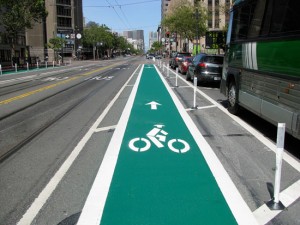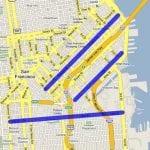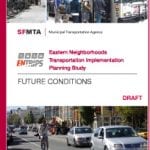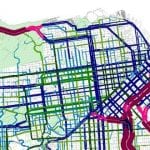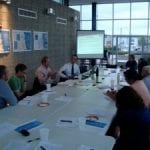The ENTRIPS Community Task Force met again this week with representatives from SFMTA. We met in the South Beach Harbor Community Room, ate pizza in the sunshine, and listened to the neighboring crowd cheer for the Giants win. In our conversation we discussed the project evaluation framework, creating three different tracks for projects to follow, and looked at the overall project list.
Evaluation Framework
The evaluation framework is the funnel into which all the potential projects will be poured. This tool, if properly built, will give each of the potential projects a score for different criteria such as Environment, Health, Cost, or Access Improvement. We intended this meeting to be focused on turning the current evaluation framework into a usable tool, though our discussion ended up turning into a review of the project list. We decided that anyone who has ideas about refining the evaluation framework should email Timothy.Papandreou@sfmta.com while CCing peter@urbanecology.org by September 3rd. SFMTA will then take the first attempt at creating the usable version of the evaluation framework.
Three Project Tracks
In SFMTA’s powerpoint (embedded below), they described a project development workflow that tried to address many of our Task Force concerns about different scales of projects. The big potential pool of projects will get scored based on the evaluation framework. Before we compare the scored projects though, we would first group them into three different tracks:
Major Corridor Bundles – These groups of larger projects along high priority corridors will require a full EIR before they can be built.
Neighborhood Packages – These smaller projects grouped by geography can be fast tracked so that each neighborhood begins to see rapid improvements.
Other Eastern Neighborhood projects – This track, which would include all of the policy and programmatic projects, would be examined on their own.
Credit: Streetsblog.com
Tim elaborated some on the second track, explaining that he had just formed an inter-agency group focused on rapidly deploying pilot projects. They have the ability to do all the affordable projects quickly, without needing a full environmental review. The green bike lanes on Market St were used as an example. The task force praised this idea as it would give each of the neighborhoods quick and tangible improvements to enjoy.
The Project List
We’ve been holding back on doing a detailed review of the project list because it is so thick and daunting. Today was the first time we made the list available to the Task Force. Our discussion was split between opinions of keeping the project list small so that we don’t spend too many resources on unfeasible projects or opening the list up so that we can do examine all the potential projects that have a place in a long term planning study. It is going to take each of us some time to look through the list and see if everything is there (or too much). The updated project list is available on our Documents page. We will discuss the list again in the future once we have a refined evaluation tool that we can filter the list with.
Next Steps
Please review the evaluation framework email in your thoughts to Timothy and Peter. We will call another meeting of the Task Force once we have a usable evaluation framework tool.

